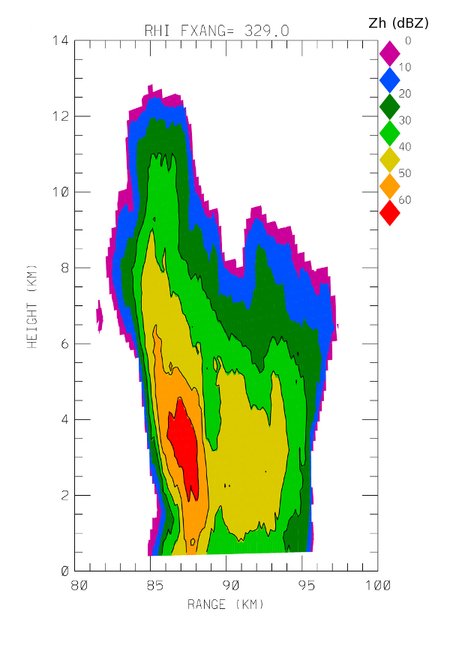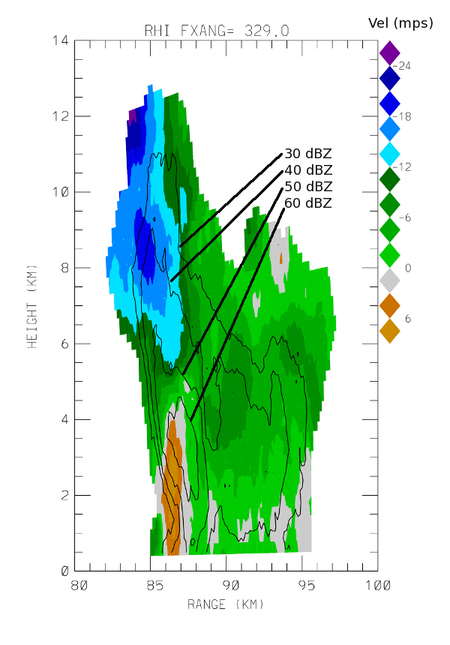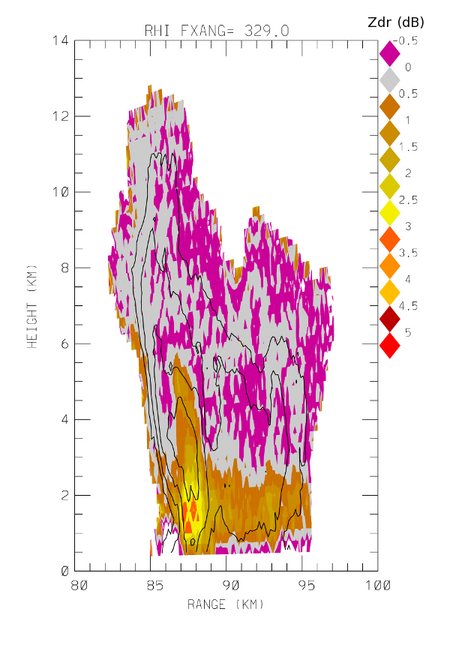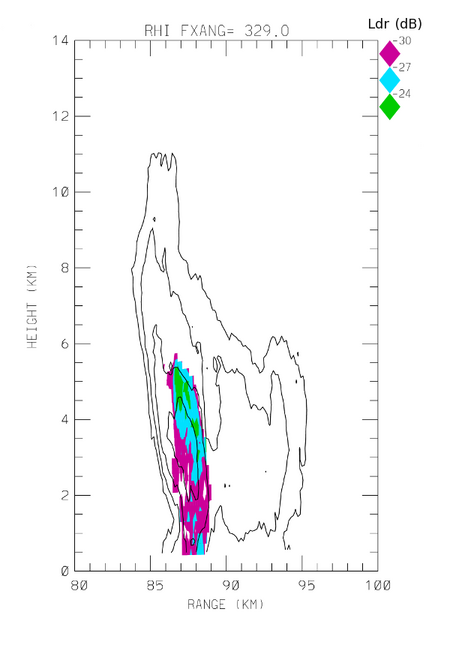Time lapse photography of a cumulonimbus cloud: 2 July 2009: Difference between revisions
Pat kennedy (talk | contribs) (Adding RHI scan section text) |
Pat kennedy (talk | contribs) No edit summary |
||
| (2 intermediate revisions by the same user not shown) | |||
| Line 1: | Line 1: | ||
== Introduction == | == Introduction == | ||
Raindrops larger than ~1 mm in diameter tend to assume flattened equilibrium shapes. On average, the diameter of such drops is larger in the horizontal plane than in the vertical plane. Due to this preferred shape and orientation, raindrops typically cause positive differential reflectivity ( | Raindrops larger than ~1 mm in diameter tend to assume flattened equilibrium shapes. On average, the diameter of such drops is larger in the horizontal plane than in the vertical plane. Due to this preferred shape and orientation, raindrops typically cause positive differential reflectivity (<math>Z_{dr}</math>) values to be observed by dual polarization weather radars. (<math>Z_{dr}</math> is 10 log10(Zh / Zv), so it is positive when Zh > Zv and it is 0 dB when Zh = Zv). When raindrops freeze, they are no longer subject to flattening by aerodynamic forces; the resultant ice particles also tend to gyrate through a large range of spatial orientations. The combination of these factors acts to reduce the <math>Z_{dr}</math> towards 0 dB as raindrops completely freeze. | ||
Due to their mass, raindrops do not immediately freeze when subjected to sub 0C temperatures. One manifestation of this freezing delay can be the observation of positive | Due to their relatively large mass, raindrops do not immediately freeze when subjected to sub 0C temperatures. One manifestation of this freezing delay can be the observation of positive <math>Z_{dr}</math> columns in active cumulus cloud updrafts. Raindrops lofted in these updrafts may ascend a kilometer or more above the ambient 0C height before they completely freeze. (See Tuttle et al. JAS 1989 pp 601-620). This article presents selected CSU-CHILL radar observations that were made in a rapidly growing section of a cumulonimbus (CB) cloud system. | ||
==Digital Camera Photography== | ==Digital Camera Photography== | ||
| Line 8: | Line 8: | ||
<center> | <center> | ||
<imgloop delay=400 imgprefix="http://www.chill.colostate.edu/anim/2jul2009_CB_lapse/" width=520 height=370> | <imgloop delay=400 imgprefix="http://www.chill.colostate.edu/anim/2jul2009_CB_lapse/" width=520 height=370> | ||
f1a.JPG| | f1a.JPG|1953:58 UTC | ||
f2a.JPG| | f2a.JPG|1955:58 UTC | ||
f3a.JPG| | f3a.JPG|1957:53 UTC | ||
f4a.JPG| | f4a.JPG|1959:53 UTC | ||
f5a.JPG| | f5a.JPG|2001:53 UTC | ||
f6a.JPG| | f6a.JPG|2003:53 UTC | ||
f7a.JPG| | f7a.JPG|2005:53 UTC | ||
f8a.JPG| | f8a.JPG|2007:53 UTC | ||
f9a.JPG| | f9a.JPG|2009:53 UTC | ||
f10a.JPG| | f10a.JPG|2011:53 UTC | ||
</imgloop> | </imgloop> | ||
</center> | </center> | ||
==RHI Scan Data== | ==RHI Scan Data== | ||
An upward RHI scan on an azimuth of 329 degrees ended at 2005:27 UTC, shortly before the exposure time of the seventh frame in the animation loop. This animation frame is shown below; the 329 degree azimuth intercepted a rapidly-growing cloud top area at | An upward RHI scan on an azimuth of 329 degrees ended at 2005:27 UTC, shortly before the exposure time of the seventh frame in the animation loop. This animation frame is shown below; the 329 degree azimuth intercepted a rapidly-growing cloud top area at 2005:53 UTC. | ||
[[Image:F7a rhi plane.JPG|520px]] | [[Image:F7a rhi plane.JPG|520px]] | ||
| Line 40: | Line 40: | ||
[[Image:Lt 2jun09 web.png|450px]] | [[Image:Lt 2jun09 web.png|450px]] | ||
==Acknowledgments== | |||
These data were collected as a part of the [[Educational Outreach#Research_Experience_for_Undergraduates|REU]] project of Sara Christensen. | |||
[[Category:Featured Articles]] | |||
[[Category:Thunderstorm Development]] | |||
Latest revision as of 12:57, 30 December 2009
Introduction
Raindrops larger than ~1 mm in diameter tend to assume flattened equilibrium shapes. On average, the diameter of such drops is larger in the horizontal plane than in the vertical plane. Due to this preferred shape and orientation, raindrops typically cause positive differential reflectivity () values to be observed by dual polarization weather radars. ( is 10 log10(Zh / Zv), so it is positive when Zh > Zv and it is 0 dB when Zh = Zv). When raindrops freeze, they are no longer subject to flattening by aerodynamic forces; the resultant ice particles also tend to gyrate through a large range of spatial orientations. The combination of these factors acts to reduce the towards 0 dB as raindrops completely freeze.
Due to their relatively large mass, raindrops do not immediately freeze when subjected to sub 0C temperatures. One manifestation of this freezing delay can be the observation of positive columns in active cumulus cloud updrafts. Raindrops lofted in these updrafts may ascend a kilometer or more above the ambient 0C height before they completely freeze. (See Tuttle et al. JAS 1989 pp 601-620). This article presents selected CSU-CHILL radar observations that were made in a rapidly growing section of a cumulonimbus (CB) cloud system.
Digital Camera Photography
The following photographs were taken looking towards the northwest from the CSU-CHILL radar site during the early afternoon hours on 2 July 2009. The camera was adjusted to take a picture at 2 minute intervals. The range to the cumulonimbus cloud cluster is ~90 km.
|
|
||
|
RHI Scan Data
An upward RHI scan on an azimuth of 329 degrees ended at 2005:27 UTC, shortly before the exposure time of the seventh frame in the animation loop. This animation frame is shown below; the 329 degree azimuth intercepted a rapidly-growing cloud top area at 2005:53 UTC.
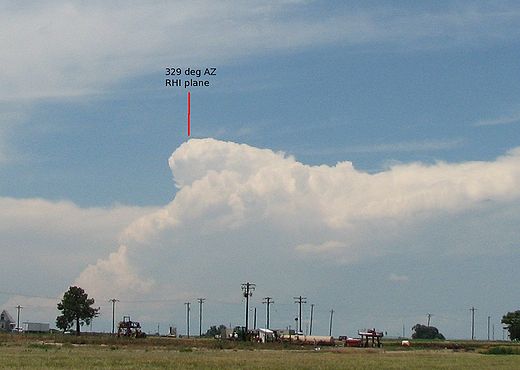
The summit of the reflectivity pattern reached heights of ~12.5 km AGL (13.9 km MSL) at a range of about 85 km.
The radial velocity pattern contained low level convergence and high level divergence in association with the highest echo tops. The inferred strong updraft is in agreement with the rapid cloud top growth seen in the cloud image loop.
Positive values extend to ~5.5 km AGL as raindrops were carried aloft in the updraft. (Based on radiosonde data, the environmental 0 deg C height was located near 3.4 km AGL.)
The Linear Depolarization Ratio (LDR) is a comparison of the strength of the (small) cross-polarized signal return to that of the co-polarized signal return. The cross-polar return signal component is enhanced when the major axis of non-spherical scatterers becomes oriented at large (~45 degree) angles to the plane of the electric field in the illuminating radar pulse. The increasingly large “wobbling” motions of the freezing raindrops contributed to an LDR maximum in the upper portion of the positive Zdr column. (To eliminate the effects of noise, LDR values are only plotted when the cross-polar receiver channel signal to noise ratio exceeded +10 db.)
Acknowledgments
These data were collected as a part of the REU project of Sara Christensen.

